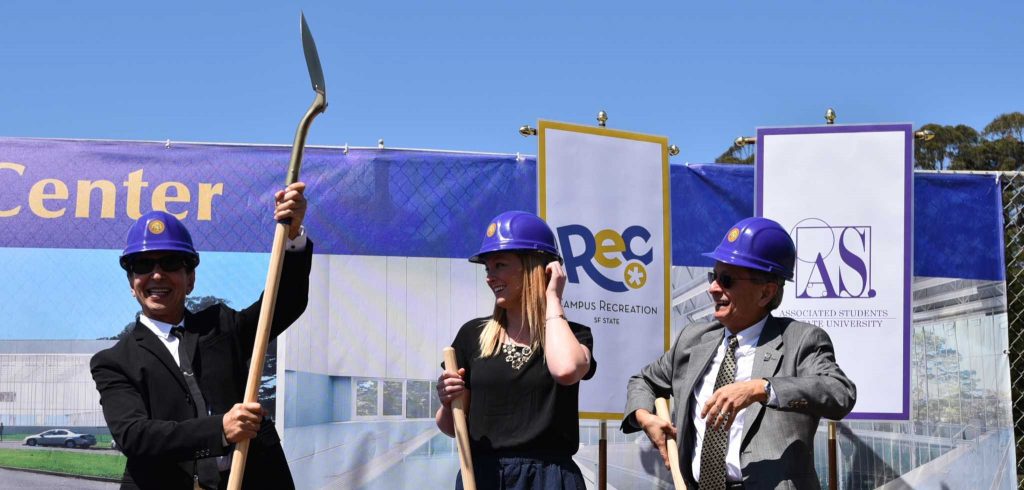
(From left) SF State alumnus and Bebe Stores founder Manny Mashouf, raises his shovel next to Phoebe Dye, president of Associated Students, Inc. and President Leslie E. Wong during the Mashouf Wellness Center groundbreaking ceremony at the SF State softball field Thursday, June 25, 2015. (Xpress / Qing Huang)
Members of the SF State community donned purple hard hats for the Mashouf Wellness Center groundbreaking ceremony June 25. The ceremony was held at the corner of Font and Merced boulevards, where the new $86 million structure will wrap around the existing softball field.
Campus planner Wendy Bloom said the project will benefit SF State by providing a new activity center close to both classrooms and student housing
“The Mashouf Wellness Center advances the principles of the campus master plan by enriching student life, modeling sustainability and strengthening the university’s public presence at its southern gateway,” Bloom said.
ASI President Phoebe Dye said she and ASI executive board members, President Leslie E. Wong and his cabinet, Campus Recreation and members of the SF State community attended the event.

Last October, Associated Students, Inc. confirmed the center will be named after alumnus and founder of Bebe Stores, Manny Mashouf, who donated $10 million toward the project. The donation is the largest individual gift SF State has ever received, according to an Xpress article.
In addition to Mashouf’s donation, a majority of funding for the center comes from a student body center fee, which SF State first implemented in 2010, according to Bloom. The fee began at $35 per semester then increased in 2012 to $90. By the time the facility opens, the fee is scheduled to reach $160 per semester.
Because the project has been primarily funded through student fees, members of the Student Union at San Francisco State said they are unhappy that students had no input in naming the center, according to Shannon Jose, the president of SUSF.
“We want the students to know that the administration did not follow school regulation for the naming of the health and wellness center,” Jose said in an email. “We also want to stress that the students have also put in money from their wallets to fund this building and that’s why the students have the right to be the ones to name it, or at least be given the opportunity to give input on the student health and wellness center.”
At the ceremony Jose said she attempted to deliver a letter to Mashouf from the SUSF voicing their concern, but said she was prevented from doing so.
A portion of the letter to Mashouf states: “In the process of naming the building, President Wong and the Administration overstepped their bounds by blatantly disregarding the democratic process required for student funded operations… [The] donation was done in good faith, however, being that the building has been funded by multiple generations of SF State students, we feel the name should reflect the spirit of the general student body rather than one individual.”
Jose and SUSF asked that a democratically selected committee be utilized to name the building and time be allotted for student input.
“Our opinion is that the process in which the name for the health and wellness center must be evaluated again and that the administration needs to stop overlooking student regulations and voices,” Jose said.
Dye said the ceremony honored Mashouf and his family for their contribution toward the center.
“Many people, including myself, spoke a few words of gratitude to Mr. Mashouf and his generosity,” Dye said. “After putting on our purple hard hats, we turned the dirt and commenced the groundbreaking.”
ASI has been very involved in many aspects of planning and developing of the center, Dye said.
“Since the student referendum confirming that students wanted a portion of their fees to pay into a recreation and wellness center, ASI has been a major part of the planning processes all the way from the blueprints and renderings and will continue to play a major part once the center is built and open,” Dye said.
Student representatives of ASI, the Cesar Chavez Student Center and the campus recreation department have helped with plans for the center since early on, including a feasibility and programming study in 2009, and with the selection of the design architect in 2012, Bloom said.
Currently ASI is working on establishing a Mashouf Wellness Center Advisory Assembly to oversee matters related to the center. The assembly will be comprised of board members, students, members of the Campus Recreation Department and others who have played a large role in creating the center, according to Dye.
“This assembly has been charged with handling many of the very detailed aspects of building an $86 million building,” Dye said.
According to a Mashouf Wellness Center Summary provided by Bloom, the building will include two gyms, an elevated jogging track, lap and recreation pools, a climbing wall and many more features. Construction of the center is expected to be completed January 2017.
As construction begins, Dye said there should be no significant impact on students.
“I would also like students to know that anyone can help with the planning process as we begin building and making decisions about the programmatic aspects of the center,” Dye said.
She asks that students interested in helping with plans for the center contact her at president@asi.sfsu.edu.
